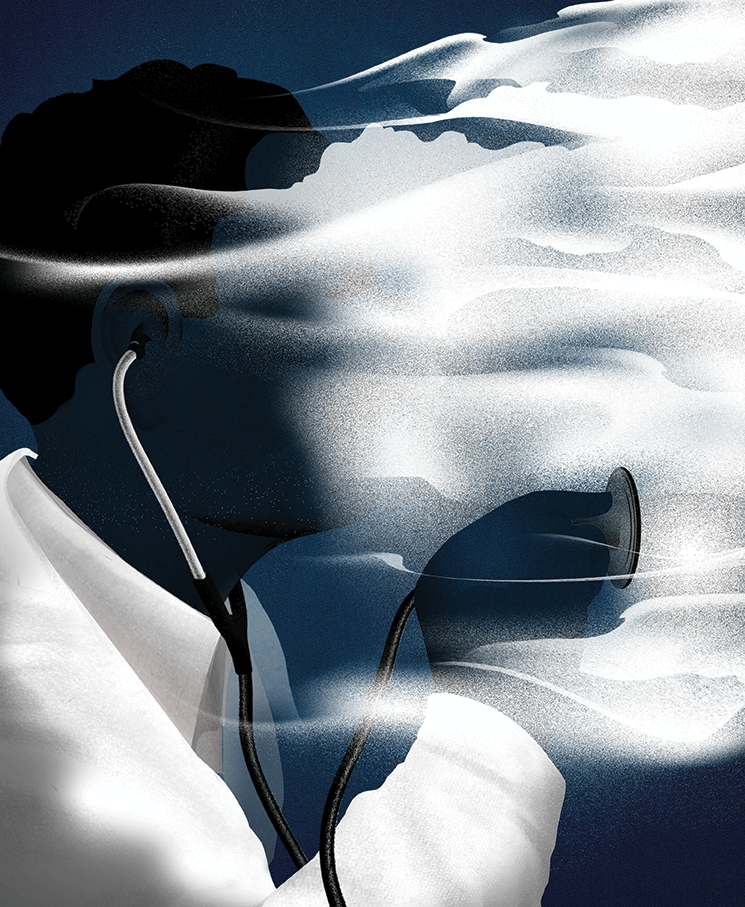Sean Callahan had never seen a patient quite like Alex Mitchell before. Breathing devices were the only thing keeping the 20-year-old Provo man alive, and he was getting worse by the moment. But why Alex was in the University Hospital intensive care unit in Salt Lake City and not hiking around in the mountains—his favorite pastime—was a mystery.
His blood oxygen levels were dangerously low and plunging. His symptoms suggested that he had a type of pneumonia that typically occurs in people 50 years older. Yet tests showed no sign of bacterial or viral infection in his lungs. Nothing about Alex’s condition made sense. For an instant, Callahan, an experienced University of Utah Health pulmonologist, was frightened. Really frightened.
“As a physician, you don’t want to take care of someone who is going to die so young,” Callahan says. “It honestly was a terrifying experience.”
Ultimately, Callahan and his colleagues would save Alex’s life. But in the months ahead (between June and December 2019), more than 31 seriously ill patients—an average of one per week—would be admitted to the hospital with symptoms eerily similar to his.
During that time, U of U Health physicians would become a focal point in a nationwide effort to understand and treat something new and perplexing. But before they could come to grips with it, this strange medical phenomenon would be linked to more than 2,500 hospitalizations in all 50 states—and 55 deaths, including one in Utah—before the end of 2019.
The search for a culprit would eventually carry U physicians and researchers down a vaporous trail leading to a pair of intriguing suspects: e-cigarettes and the marijuana-tinged liquid cartridges sometimes used in them.
Mapping a new illness
Sorting out a medical mystery like this one is a bit like early European explorers trying to map the New World. One of the first renderings depicted North America shaped like a small wishbone from a turkey rather than as the vast continent that it really is. It would take hundreds of years for cartographers to uncover its real majesty.
But doctors didn’t have centuries to figure out what was going on with Alex. Nor could they afford imprecision. Fortunately, they got an important clue early on. A visiting physician, who had been consulted on the case before Alex was moved to University Hospital, had heard of similar symptoms in another patient in California who used e-cigarettes, commonly known as vaping. Alex vaped. Could that have something to do with his condition?
Initially, Callahan and his colleagues were skeptical. Alex’s situation seemed much more severe than that case and others they had heard of. But soon, other patients would confirm that they also had vaped, and many were in just as dire shape as Alex.
“There’s an old saying that if you can’t figure out what’s going on with a patient, it’s either a new disease or you’re not listening hard enough,” explains Scott Aberegg, a critical care pulmonologist at U of U Health. “In some ways, we weren’t listening hard enough, because, like everybody else, we were dismissing the hazards of vaping.”
By early July, the Centers for Disease Control and Prevention (CDC) was tracking outbreaks of this condition that quickly became known as e-cigarette, or vaping, product use-associated lung injury (EVALI). As cases continued to mount, Callahan and Aberegg were consulting with CDC scientists at least once a week, sharing their growing expertise in diagnosing and treating these patients while learning more about what was going on nationally. What was once considered a fluke was now a national health emergency, and hundreds of thousands, if not millions, of e-cigarette users—many of them teens and young adults—were at risk.
The vaping generation
Officially they’re known as Gen Z. But young Americans born between 1997 and 2012 could also be dubbed Gen V—as in vaping. They might not remember much about 2007, the year e-cigarettes—devices that heat liquid to produce a vapor that users inhale into their lungs—were introduced in the United States. But little over a dozen years later, vaping has skyrocketed among this generation.
Since 2017, the percentage of high school students who vape has risen almost 2.5 times, from 11.7% to 27.5%, according to the CDC. The numbers for middle school students are even more sobering, leaping from 3.3% to 10.5% over the same span.
In Utah, about 12% of teens reported vaping in 2019, according to the Utah Department of Health. But, as in the rest of the country, vaping becomes more prevalent as Utah teens get older, ranging from 7% at age 13 to more than 15% among 16- to 17-year-olds. Vaping trails off among 19- to 24-year-olds, and by the late 20s, less than 9% of Utahns do it.
Many young vapers do it because they perceive that it is nonaddictive and safer than smoking conventional tobacco (emerging evidence suggests it’s not). Some enjoy the sweet flavorings—including German chocolate cake and banana split—infused into the disposable vaping liquids (now banned from refillables). For others, it’s the ability to discreetly get a puff of nicotine or other substances without producing lingering smells that might alarm parents, teachers, and other adults.
Whatever the reasons, by mid-July 2019 it was clear something had gone haywire. Vaping had turned vicious.
How to Talk to Kids about Vaping
Social workers Jessica Holzbauer and Liz Wetmore counsel teens and young adults on a daily basis at the University Neuropsychiatric Institute. We asked their advice on how to bring up and discuss vaping.
Do your homework. A bit of knowledge is good, but avoid trying to come across as an expert. Let them know that you have a basic under-standing of vaping and, like them, are trying to find out as much as you can. Start by checking out websites such as the Centers for Disease Control and Prevention, the National Institutes of Health, and the Food and Drug Administration.
Take advantage of cues. A billboard, a TV ad, a vape shop, or seeing someone vaping on the street are wonderful opportunities to raise the topic, Wetmore says. “Hmm, what do you think about that?” or “I’m curious, what do these ads or people you see make you think about vaping?” That kind of conversation starter will feel more genuine and natural and likely lead to more honest answers.
Keep it casual. A calm voice and nonthreatening body language will help keep young people engaged, Holzbauer says. Sit with them; don’t stand over them. Ask open-ended questions such as, “What do you think about vaping?” or “When you talk to your friends about vaping, what do they say? What do you say?” Being curious rather than confrontational will help them feel like equal, informative partners in the conversation.
Shorter is better. Start by planting a seed with short one- or two-minute conversations. You can always come back to the topic later. “Your kids will know you’re aware of vaping and interested in their opinions,” Wetmore says.
Stay in the here and now. Keep the conversation on your kids and their experiences. Kids can have a hard time relating to you because so much has changed since you were younger. “Talking about your own experiences with peer pressure and substances will likely shut down a conversation quickly,” Holzbauer advises.
Know your child. Use these tips as guidelines, not gospel. “Most parents know what best motivates their children,” Wetmore says. “Just because one approach works for other adults and kids down the street doesn’t mean it will work for you.”
‘He’s as sick as you can be without being dead’
A funeral. It was something that Monica and Daniel Mitchell didn’t want to contemplate. But the way things were going for their son, Alex, it was a hard subject to avoid.
Lying before them in the cardiac ICU, Alex was suffering from what his doctors called acute respiratory distress syndrome. But no one was sure why. All Monica and Daniel knew was that Alex was very sick. He’d been intubated and was on a ventilator to help him breathe. He was sedated and temporarily paralyzed to keep him from breathing against the ventilator.
Then there was the large IV threaded into his heart cavity so he could more directly and safely receive medicines, such as the drug keeping his blood pressure artificially elevated. Soon, doctors would add extracorporeal membrane oxygenation, or ECMO, using a machine that pumps and oxygenates a patient’s blood outside the body, allowing the heart and lungs to rest.
“One of his doctors told us that Alex was as sick as you can be without being dead,” Monica recalls. “It was really scary, and I knew that he might not make it, but I couldn’t face that possibility. I kind of put it off in a corner of my mind.”
Just days earlier, Alex had been fine: hanging out with friends, hiking, and preparing for the next phase of life in college. He vaped, but both he and his parents thought it was better than smoking, which he had started doing when he was 16. Two years later, he switched to vaping for a couple of reasons. First, to save money: a pack of cigarettes cost $7; a vape pod cost $20 but lasted longer and contained the same or more nicotine. Then there was the convenience: having to go outside to smoke every two hours was a drag.
“I knew it wasn’t healthy because you’re still inhaling something into your lungs that’s not supposed to be there,” Alex says. “And there was the nicotine, which I knew was addictive. So, I figured there might be trouble for me down the road, but there was nothing on the radar that suggested that this kind of thing would happen.”
“This kind of thing” began in mid-June, when Alex began to feel nauseous and achy, and had difficulty breathing. He and his family suspected the flu, but when his symptoms worsened, he went to urgent care, where a doctor diagnosed pneumonia, prescribed antibiotics, and sent him home.
But before he could get there, the urgent care physician, who had reconsidered his assessment, called and recommended that Alex seek care at Mountain View Hospital in Payson. There, doctors were puzzled because tests for bacterial pneumonia and other common respiratory ailments were negative. However, Alex did have some abnormal immune cells in his lungs that are associated with lipoid pneumonia, a rare, potentially deadly condition that usually occurs in older people who accidentally breathe in oil-based laxatives. Alex didn’t fit that profile. Yet he continued to falter.
On June 24, he was airlifted to University Hospital, where the next steps taken by U doctors and nurses would determine his fate.
‘We shared information like it was wildfire’
Standing next to Alex’s bed in the ICU, Callahan gave no hint that he was just as shocked and bewildered as Alex’s parents, who sat just feet away. Instead, Callahan focused on keeping Alex alive. “A dying 20-year-old with pneumonia in the middle of the summer gets your attention, particularly since he had clinically worsened throughout the day,” he says.
Over the next few days, Callahan, in consultation with Aberegg, Sean Maddock, Meghan Cirulis MD’14, Lynn Keenan, Cheryl Pirozzi MS’15, and Sanjeev Raman and others on the hospital’s pulmonary critical care team, would reach out to colleagues at University Hospital—as well as those across the country—seeking answers.
“We shared information among ourselves like it was a wildfire,” Aberegg says. “It was that kind of community engagement among hospital staff that helped make sure that we didn’t miss something that might be important in treating Alex and these other patients.”
A bronchoalveolar lavage, a procedure used to gather samples of lung tissue, soon confirmed that Alex had something similar to lipoid pneumonia, but without its characteristic features. Not having much else to go on, his doctors began treating him with steroids in hopes of reducing the inflammation in his lungs. It worked. Within days, Alex was well on his way to recovery.
But what had caused his lung failure remained a mystery until Alex mentioned that he vaped THC, the active ingredient in marijuana, which is illegal for recreational use in Utah. As other patients were admitted to University Hospital with similar symptoms, doctors found a link. At least 80% of these patients had recently vaped THC. It was a trend that matched a pattern nationwide.
In the weeks ahead, U doctors would examine lung tissue samples from these patients. They all shared an unusual characteristic: large immune cells containing oily droplets like those found in Alex. Based on this finding, the team identified the cells as a possible bio-marker that could help other doctors diagnose the mystery disease more quickly and accurately.
After publishing the results and hold-ing a press conference—the first to paint a picture of doctors’ and patients’ experiences with the new illness—Callahan and Aberegg were sought out by dozens of media outlets, including the New York Times, Rolling Stone, and the Wall Street Journal. Colleagues at hospitals nationwide were seeking their expertise and advice.
But Callahan and Aberegg suspected there was more to the story. People had been vaping THC for years without any ill effects. The cartridges involved in the outbreak had been purchased legally at vape shops in other states as well as illegally off the street in Utah. So, they surmised that some sort of contaminant had recently tainted THC cartridges.
In November, the CDC confirmed their suspicions, announcing that vitamin E acetate, a substance used to dilute THC prior to sale, was the likely culprit behind the EVALI outbreak. A supplement found in many foods and cosmetic products, vitamin E acetate is an enormously sticky substance, and when inhaled as a vapor, coats the lungs like honey, triggering an immune reaction that leads to EVALI.
A dying 20-year-old with pneumonia in the middle of the summer gets your attention.
Finding a new normal
The vaping epidemic reached its peak in September, falling from 216 patient admissions nationwide to 26 in late November, likely due to diminishing use of vitamin E acetate in THC cartridges. At University Hospital, doctors are still admitting about one patient per month, Aberegg says. Meanwhile, researchers are investigating why EVALI occurs in the 10% to 20% of vapers who don’t use THC.
In any case, the experience has changed how Callahan, Aberegg, and other U physicians evaluate patients. Prior to the crisis, they rarely asked about vaping or THC use. Now they always do.
“I don’t think we had any one brilliant eureka moment,” Aberegg says of the experience of being on the leading edge of the public health crisis. “It was a combination of diligence and serendipity.
Perhaps the main thing was having a group of smart, dedicated medical professionals who worked well together and rose to the challenge.”
Alex Mitchell continues to recover. Although his lung capacity remains about 25% below normal, he has begun hiking again, taking frequent stops for rest. He no longer smokes or vapes. While he considers his experience a cautionary tale, he believes individuals should evaluate the risks, then make their own choices about smoking or vaping.
In the future, he hopes to attend college, majoring in something that perhaps Callahan and Aberegg can relate to after treating him: chaos theory.
About the author: Doug Dollemore is a senior science writer for U of U Health.



Why is this being treated as the issue, when the real issue is people using underground products because safe ones are illegal?
I see a vaping store on every other corner. I think you are talking about marijuana. This article is talking about vaping in general, e-cigarettes mostly. Smoking anything is bad for you. Vaping or not. It’s science. Anything but oxygen is not meant to be in your lungs, including pollution. There is no such thing as healthy vaping.
Even the inventor of the e-cigarette said that the product was only intended to help smokers quit tobacco and was only safer than smoking, not safe in general. The people who label these products as save are those who have a stake in the business, like philip morris companies (now altria group) who own marlboro and have a 35% stake in juul.
Back in 1964 my talented brother was 1.) the Senior Class President at Highland High School in SLC, 2.) planned to attend the University of California in Berkeley that fall, and 3.) had his whole life ahead of him. Marijuana used to be called “the weed,” and his use of this much weaker form of THC cast a shadow across the next 56 years of his life, rendering him a stranger to family members and friends who chose to abstain.
I am an Industrial Hygienist with UOSH Consultation. We look at all types of air contaminants in workplaces, in parts per million quantities. It amazes me that people are self-volunteering as test subjects for inhaling contaminants into their lungs. It has long been known that introducing such things to a person’s body, even in minute quantities, can have lasting and sometimes dire effects. Some effects don’t show up for years but are ultimately fatal. It is, unfortunately, part of being young that people in this part of life don’t get the long-term picture and are less likely to listen to those who do.
I’m curious why vitamin E acetate began being used in THC vape cartridges in the first place? Is there a list of substances that are “generally recognized as safe” for inhaling into the lungs like there is with food and supplements? It seems reckless and cavalier for manufacturers to mass produce untested compounds for the general public to inhale…
There is no “safe” alternative for intentionally inhaling foreign chemicals into your body. No matter how the marketing team strategizes their goal to make all teens addicted to nicotine, there is no pretty way to view it: addiction is addiction. There are NO safe ways to inhale smoke.